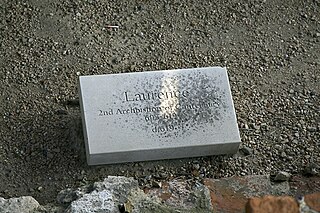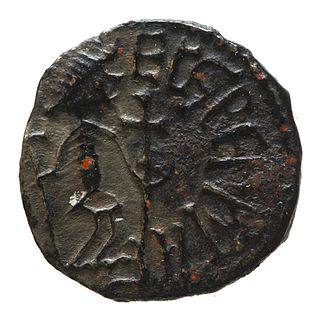Related Research Articles

Laurence was the second Archbishop of Canterbury, serving from about 604 to 619. He was a member of the Gregorian mission sent from Italy to England to Christianise the Anglo-Saxons from their native Anglo-Saxon paganism, although the date of his arrival is disputed. He was consecrated archbishop by his predecessor, Augustine of Canterbury, during Augustine's lifetime, to ensure continuity in the office. While archbishop, he attempted unsuccessfully to resolve differences with the native British bishops by corresponding with them about points of dispute. Laurence faced a crisis following the death of King Æthelberht of Kent, when the king's successor abandoned Christianity; he eventually reconverted. Laurence was revered as a saint after his death in 619.

Offa was King of Mercia, a kingdom of Anglo-Saxon England, from 757 until his death. The son of Thingfrith and a descendant of Eowa, Offa came to the throne after a period of civil war following the assassination of Æthelbald. Offa defeated the other claimant, Beornred. In the early years of Offa's reign, it is likely that he consolidated his control of Midland peoples such as the Hwicce and the Magonsæte. Taking advantage of instability in the kingdom of Kent to establish himself as overlord, Offa also controlled Sussex by 771, though his authority did not remain unchallenged in either territory. In the 780s he extended Mercian Supremacy over most of southern England, allying with Beorhtric of Wessex, who married Offa's daughter Eadburh, and regained complete control of the southeast. He also became the overlord of East Anglia and had King Æthelberht II of East Anglia beheaded in 794, perhaps for rebelling against him.

Coenwulf was the King of Mercia from December 796 until his death in 821. He was a descendant of King Pybba, who ruled Mercia in the early 7th century. He succeeded Ecgfrith, the son of Offa; Ecgfrith only reigned for five months, and Coenwulf ascended the throne in the same year that Offa died. In the early years of Coenwulf's reign he had to deal with a revolt in Kent, which had been under Offa's control. Eadberht Præn returned from exile in Francia to claim the Kentish throne, and Coenwulf was forced to wait for papal support before he could intervene. When Pope Leo III agreed to anathematise Eadberht, Coenwulf invaded and retook the kingdom; Eadberht was taken prisoner, was blinded, and had his hands cut off. Coenwulf also appears to have lost control of the kingdom of East Anglia during the early part of his reign, as an independent coinage appears under King Eadwald. Coenwulf's coinage reappears in 805, indicating that the kingdom was again under Mercian control. Several campaigns of Coenwulf's against the Welsh are recorded, but only one conflict with Northumbria, in 801, though it is likely that Coenwulf continued to support the opponents of the Northumbrian king Eardwulf.

Oda, called the Good or the Severe, was a 10th-century Archbishop of Canterbury in England. The son of a Danish invader, Oda became Bishop of Ramsbury before 928. A number of stories were told about his actions both prior to becoming and while a bishop, but few of these incidents are recorded in contemporary accounts. After being named to Canterbury in 941, Oda was instrumental in crafting royal legislation as well as involved in providing rules for his clergy. Oda was also involved in the efforts to reform religious life in England. He died in 958 and legendary tales afterwards were ascribed to him. Later he came to be regarded as a saint, and a hagiography was written in the late 11th or early 12th century.

Ealhswith or Ealswitha was the wife of King Alfred the Great. Her father was a Mercian nobleman, Æthelred Mucel, Ealdorman of the Gaini, which is thought to be an old Mercian tribal group. Her mother was Eadburh, a member of the Mercian royal family. Ealhswith is commemorated as a saint in the Christian East and the West on 20 July.

Ecgfrith was king of Mercia from 29 July to December 796. He was the son of Offa, one of the most powerful kings of Mercia, and Cynethryth, his wife. In 787, Ecgfrith was consecrated king, the first known consecration of an English king, probably arranged by Offa in imitation of the consecration of Charlemagne's sons by the pope in 781. Around 789, Offa seems to have intended that Ecgfrith marry the Frankish king Charlemagne's daughter Bertha, but Charlemagne was outraged by the request and the proposal never went forward.

Ecgbert was an 8th-century cleric who established the archdiocese of York in 735. In 737, Ecgbert's brother became king of Northumbria and the two siblings worked together on ecclesiastical issues. Ecgbert was a correspondent of Bede and Boniface and the author of a legal code for his clergy. Other works have been ascribed to him, although the attribution is doubted by modern scholars.

Eadfrith of Lindisfarne, also known as Saint Eadfrith, was Bishop of Lindisfarne, probably from 698 onwards. By the twelfth century it was believed that Eadfrith succeeded Eadberht and nothing in the surviving records contradicts this belief. Lindisfarne was among the main religious sites of the kingdom of Northumbria in the early eighth century, the resting place of Saints Aidan and Cuthbert. He is venerated as a Saint in the Roman Catholic Church, and in the Eastern Orthodox Church, as also in the Anglican Communion.
Wilfrid II, name also spelled Wilfrith, also known as Wilfrid the Younger, was the last Bishop of York, as the see was converted to an archbishopric during the time of his successor.

Crayke is a village and civil parish in the Hambleton District of North Yorkshire, England, about 2 miles (3.2 km) east of Easingwold.
Gisela, was a daughter of Charlemagne from his marriage to Hildegard.
Eardwulf was king of Northumbria from 796 to 806, when he was deposed and went into exile. He may have had a second reign from 808 until perhaps 811 or 830. Northumbria in the last years of the eighth century was the scene of dynastic strife between several noble families: in 790, king Æthelred I attempted to have Eardwulf assassinated. Eardwulf's survival may have been viewed as a sign of divine favour. A group of nobles conspired to assassinate Æthelred in April 796 and he was succeeded by Osbald: Osbald's reign lasted only twenty-seven days before he was deposed and Eardwulf became king on 14 May 796.
Milred was an Anglo-Saxon prelate who served as Bishop of Worcester from c. 744 until his death in 774.
Anglo-Latin literature is literature from Britain originally written in Latin. It includes literature written in Latin from parts of Britain which were not in England or English-speaking: "Anglo-" is used here as a prefix meaning British rather than English.
Botwine was a Northumbrian saint venerated at Ripon and Peterborough. He is well documented as a priest, and latter Abbot of Ripon. The Anglo-Saxon Chronicle recension E, recorded his death in the 780s in one of three Ripon abbatial obits derived from a chronicle of Northumbrian origin. Following the death of St Botwine in 786AD, his replacement, Ealdberht was elected and consecrated Abbot. Ealdberht died in 788AD, and was himself succeeded as Abbot by St. Sigered of Ripon.

Frithegod, was a poet and clergyman in the mid 10th-century who served Oda of Canterbury, an Archbishop of Canterbury. As a non-native of England, he came to Canterbury and entered Oda's service as a teacher and scholar. After Oda's death he likely returned to the continent. His most influential writing was a poem on the life of Wilfrid, an 8th-century bishop and saint, named Breviloquium Vitae Wilfridi. Several manuscripts of this poem survive, as well as a few other of Frithegod's poems. He was also known for the complexity of his writings, with one historian even calling them "damnably difficult".
Michael Lapidge, FBA is a scholar in the field of Medieval Latin literature, particularly that composed in Anglo-Saxon England during the period 600–1100 AD; he is an emeritus Fellow of Clare College, Cambridge, a Fellow of the British Academy, and winner of the 2009 Sir Israel Gollancz Prize.
Tatberht was an eighth century Anglo-Saxon saint, abbot and contemporary of Bede.
Wynthryth of March was an early medieval saint of Anglo Saxon England.
Æthelgifu was a daughter of Alfred the Great, King of Wessex. She was the third surviving child of the marriage between Alfred and Ealhswith in 868. Alfred's biographer, Asser, wrote that "Æthelgifu, devoted to God through her holy virginity, subject and consecrated to the rules of monastic life, entered the service of God'.
References
- ↑ The Oxford Dictionary of Saints
- ↑ Stowe MS 944, British Library
- ↑ Alchfrith 1 at Prosopography of Anglo-Saxon England
- ↑ Michael Lapidge, Anglo Saxon Literature 600-899 (Continuum, 1996) page 393.
- ↑ Michael Lapidge, Anglo Saxon Literature 600-899 (Continuum, 1996) page 393
- ↑ Hyglac letter.
- ↑ Hyglac letter at Oxford journals.
- ↑ Michael Lapidge, Anglo Saxon Literature 600-899 (Continuum, 1996) page 392.
- ↑ Peterson, Lena (2007). "Lexikon över urnordiska personnamn". Swedish Institute for Language and Folklore. p. 39. (Lexicon of Nordic Personal Names Before the 8th Century).
- ↑ Michael Lapidge, Anglo Saxon Literature 600-899 (Continuum, 1996) page 286